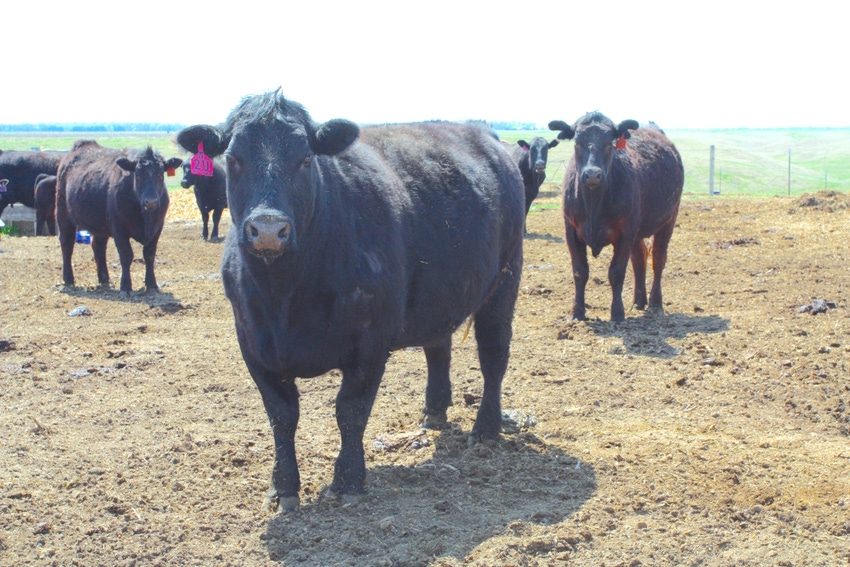April 28, 2015

In 2015, the market is driving cattle producers to restock their herds; however, as BEEF Senior Editor Burt Rutherford aptly puts it, “Drought is the wild card in any expansion plans and can stop short any rebuilding that might be planned.” One strategy ranchers are looking to is dry-lotting their herds during times of drought, and confinement, or “intensification,” is becoming a hot topic as producers aim to raise more beef using fewer resources.
READ: Confinement or semi-confinement cow-calf production is feasible
According to University of Nebraska-Lincoln’s (UNL) Beef Team, “Data suggest performance of calves and cows is similar whether they were dry-lotted or managed on pasture. Therefore, dry-lotting beef cows may be an alternative to expensive forages or hauling cattle to another location or state.”
Here are four tips for successfully dry-lotting beef cattle:
1. Consider pen size.
In general, 500 to 800 square feet per pair is recommended. A recent article by UNL’s Beef Team entitled, “Dry-lotting beef cows - a drought management strategy” says between 28 and 36 inches of bunk space per cow is recommended, depending on cow weight. Also, consider splitting cows into two groups based on age, if possible.
READ: 6 first-hand reviews of beef cow confinement
2. Forage can be used in limited amounts.
In a drought, the price of hay tends to skyrocket pretty quickly. When forage is expensive, it can be used in smaller amounts in the herd’s diet.
According to the UNL Beef Team, a rule of thumb would be to have at least 0.5% of the cow's weight on a dry-matter basis as forage to keep the rumen healthy. As an example, if the average weight of the cow herd that is being dry-lotted is 1,200 pounds, then include at least 6 pounds per head per day (1,200 lb x 0.005 = 6 lb) dry-matter basis of forage in the diet. If the forage is 85% dry matter, then feed 7 pounds per head per day (6 lb/hd/da divided by 0.85 = 7.06).
READ: Grazing Series Part 4: 7 resources for pasture management in times of drought
3. Look to distillers grains as a cheaper feed alternative.

Photo Credit: Amanda Radke
The UNL Beef Team suggests distillers grains as a cheaper feed alternative to corn, particularly in the summer where feedlot numbers are low.
According to the UNL report, “Distillers grains (wet and modified) and gluten feed can be stored in bunkers or ag bags. Distillers grains are good sources of protein, energy and phosphorus. Consider adding calcium to the diet because of the high phosphorus content of distillers grains. Mix the diet uniformly, pay attention to sulfur content, and make sure there is plenty of bunk space so all cows get their share.”
For more details on UNL research looking at different rations for dry-lotting cattle, read, “Limit feeding beef cows with bunkered wet distillers grains plus solubles or distillers solubles.”
Also, check out: “Wheat straw, distillers grains, and beef pulp for late gestation beef cows.”
4. Watch UNL’s new videos on drylotting and confinement beef cow management series
For producers who are looking to maintain cows with limited forage supplies in times of drought, UNL has a dry-lotting and confinement cow series featuring comments from Alfredo DiConstanzo, University of Minnesota beef cattle nutrition and management professor; Vern Anderson, retired North Dakota State University Extension beef specialist; and Rick Rasby, UNL Extension beef specialist.
Watch the videos here for additional tips on managing summer forages during the 2015 grazing season.
READ: Stanford University says confined livestock are better for the planet
Do you dry-lot your cattle in times of drought? What works best in your operation? Share your tips for confinement in the comments section below.
By the way, there is an excellent program pertaining to cow-calf intensification coming up this fall. Kenneth & Caroline McDonald Eng Foundation Symposium on Cow Efficiency will be held Sept. 17-18 at the Skirvin Hilton in Oklahoma City. Find out more about the program by clicking here or by calling 575-743-6331.
The opinions of Amanda Radke are not necessarily those of beefmagazine.com or Penton Agriculture.
You might also like:
12 new products for the ranch this spring
Cattle aren't the water guzzlers they're made out to be
60 stunning photos that showcase ranch work ethics
Must-Read: Montana couple uses "construction" cones to help herd cattle
You May Also Like



